Sold antiquities
Archive of sold antiquities
All artefacts sold in our gallery are fully documented in our online archive and database. Being a specialist ancient art dealer, preserving also the more recent history of each and every piece sold in our shop is at our heart. That is particularly useful for artefacts that changed owners in the meantime. Information that may have been lost in the process can be easily restored from our archives. Please do not hesitate to contact us if you need further information about ancient items that have been sold in our gallery. We can help you with reconstructing the history of ownership for those items. All information about our customers will be kept confidential, of course.-
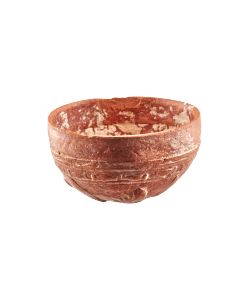 Megarian bowl decorated with a flying swan
Megarian bowl decorated with a flying swanInteresting piece, featuring a flying swan. From an old German collection
Price: on request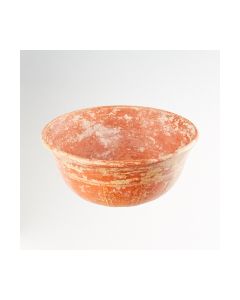 Decorated Megarian bowl from an old German collection
Decorated Megarian bowl from an old German collectionInteresting shape, perfect condition.
Price: on request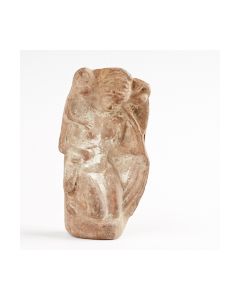 Aphrodite with erots, hellenistic - roman
Aphrodite with erots, hellenistic - romanPerfectly preserved votive or funerary cult figurine of a kneeling young woman with two children behind her.
Price: on request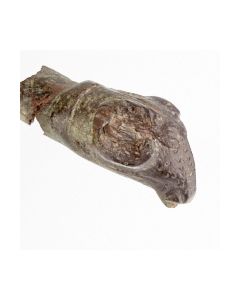 Roman bronze patera handle shaped as a ram's head
Roman bronze patera handle shaped as a ram's headImpressive, massive piece with beautiful patina.
Price: on request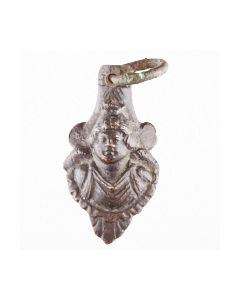 Roman brass pendant with Amor bust
Roman brass pendant with Amor bustMassive, perfectly preserved masterpiece of ancient art with beautiful black patina.
Price: on request Roman bronze portrait head, possibly one of the soldier emperors
Roman bronze portrait head, possibly one of the soldier emperorsPerfectly preserved, delicate piece of ancient art with beautiful green patina, 3. century AD
Price: on request Small Roman amphora from El-Djem, Tunis
Small Roman amphora from El-Djem, TunisPossibly produced in Hispania Baetica. From a very old German collection
Price: on request Roman oil lamp with dolphins and trident
Roman oil lamp with dolphins and tridentImpressive oil lamp with interesting maritime scene from very old German collection
Price: on request Roman jar from Lopodunum
Roman jar from LopodunumPerfectly preserved piece from the 1st - early 2nd century AD. Found in Ladenburg, Baden-Wuerttemberg, Germany.
Price: on request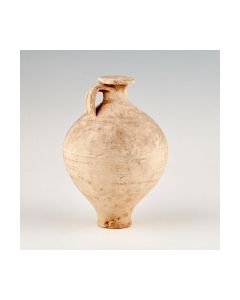 Large Roman jar from Lopodunum
Large Roman jar from LopodunumPerfectly preserved piece from the second half of the 2nd century AD. Found in Ladenburg, Baden-Wuerttemberg, Germany.
Price: on request Small Roman jar from Lopodunum
Small Roman jar from LopodunumNicely preserved piece. Found in Ladenburg, Baden-Wuerttemberg, Germany.
Price: on request Roman jar with flat handle from Lopodunum
Roman jar with flat handle from LopodunumNicely preserved piece. Found in Ladenburg, Baden-Wuerttemberg, Germany.
Price: on request Roman jar with flat handle from Lopodunum
Roman jar with flat handle from LopodunumPerfectly preserved piece. Found in Ladenburg, Baden-Wuerttemberg, Germany.
Price: on request Small Roman oil lamp - found in Lopodunum, Germany
Small Roman oil lamp - found in Lopodunum, GermanyNicely preserved piece from the earliest Roman settlement phase
Price: on request Massive Roman oil lamp - found in Lopodunum, Germany
Massive Roman oil lamp - found in Lopodunum, GermanyNicely preserved piece from the earliest Roman settlement phase
Price: on request Roman oil lamp - found in Lopodunum, Germany
Roman oil lamp - found in Lopodunum, GermanyPerfectly preserved piece from the earliest Roman settlement phase
Price: on request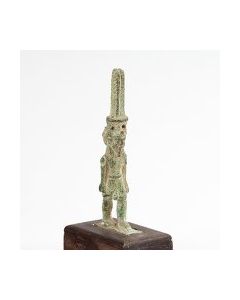 Egyptian bronze figurine of Nefertem
Egyptian bronze figurine of NefertemA major cult in Memphis saw the god related to fragrances. He is depicted here as youthful god in human form. Nice piece from the Late Period of ancient Egypt.
Price: on request Egyptian pataikos
Egyptian pataikosGod or god-like dwarf. The figurine was supposed to have a magical protective function. 26th to 30th dynasty of Ancient Egypt. From a British private museum.
Price: on request Egyptian amulet of Taweret
Egyptian amulet of TaweretIt shows the goddess of childbirth in the form of a pregnant hippopotamus. The amulet from the Late Period of Ancient Egypt should exert a protective function. From a British private museum.
Price: on request Egyptian amulet of Anubis
Egyptian amulet of AnubisThe amulet from the Late Period of Ancient Egypt was supposed to protect the dead on their way to the afterlife. From a British private museum.
Price: on request Ancient brooch of a fabulous creature
Ancient brooch of a fabulous creatureRare Hippocampus brooch with elaborate inlays of multi-coloured glass paste and metal. Great example of the brooch manufacturing of Roman Gaul during the mid 1st cent. AD.
Price: on request Roman brooch of a swimming bird
Roman brooch of a swimming birdStylized bird shaped brooch made of bronze. Northern European brooch type from the Roman Pricipate.
Price: on request Bird shaped Roman brooch
Bird shaped Roman broochProduct of Northern Europe dating to the second century AD. Brooch worked as a flat relief, once with multi-coloured inlays.
Price: on request Roman plate brooch with colourful enamel
Roman plate brooch with colourful enamelRare fibula type from Roman Britain. The fully intact multicoloured enamel makes this piece worthy of being a museum exhibit. 2nd cent. AD.
Price: on request Elaborate Roman plate brooch
Elaborate Roman plate broochTen pointed star form with leaf pattern and decorative buttons. A product of Gaul or Britain dating to the 1st century.
Price: on request Roman horse fibula
Roman horse fibulaSkillfull bronze fibula in horse shape. The type was used in Central Europe during the later Principate.
Price: on request Roman fibula
Roman fibulaAncient roman fibula of the kraeftig profilierte fibula type. The piece is a beautiful example of this common type of fibulae during roman imperial times.
Price: on request Hand axe from Galilee
Hand axe from GalileeBig paleolithic hand axe. The universal stone age tool could be use as a borer or cutting tool. Around 500,000 to 200,000 BC.
Price: on request Egyptian steatite plaque
Egyptian steatite plaqueThe protective amulet shows the god Bes between two seated monkeys. Late Period of ancient Egypt. This piece is described in the catalogue of Irène Gautier-Vodoz.
Price: on request Scaraboid with Red Crowns of Lower Egypt
Scaraboid with Red Crowns of Lower EgyptThe hieroglyphs on the lower side symbolize the rule over Lower Egypt. The rising sun is symbolized above. This scaraboid is described in the catalogue of Irène Gautier-Vodoz.
Price: on request Scaraboid with twisted cord
Scaraboid with twisted cordScaraboid seal amulet with a twisted cord motive. This scarab is described in the catalogue of Irène Gautier-Vodoz.
Price: on request Small scarab amulet with Isis hieroglyphs
Small scarab amulet with Isis hieroglyphsThe tiny amulet dates to the New Kingdom. It bears the glyphs for the goddess Isis. This scarab is described in the catalogue of Irène Gautier-Vodoz.
Price: on request Scarab with scarab motive
Scarab with scarab motiveThe stamp side shows a scarab with two uraeus snakes. This scarab is described in the catalogue of Irène Gautier-Vodoz.
Price: on request Egyptian Scarab
Egyptian ScarabThe Egyptian scarab has a central cross on the stamp side. The piece dates to the 21st dynasty of Ancient Egypt. It is described in the catalogue of Gautier-Vodoz.
Price: on request Roman intaglio with two facing heads
Roman intaglio with two facing headsThis special motive for Roman engraved gems often featured two Roman citizens or man and wife. It is an interesting example of its kind made from beautiful orange glass.
Price: on request Ancient intaglio with bust and wreath
Ancient intaglio with bust and wreathAn ancient intaglio from Roman times with interesting scene. Bust with wreath. Wonderful turquoise glass.
Price: on request

